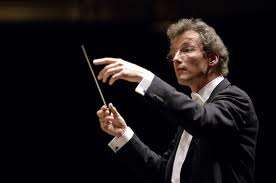|
Back
The Man Who Stayed Out In The Cold New York
Isaac Stern Auditorium, Carnegie Hall
05/23/2012 -
Johannes Brahms: Violin Concerto in D Major, Op. 77
Kaija Saariaho: Laterna magica (New York Premiere)
Dmitri Shostakovich: Symphony No. 6 in B minor, Op. 54
Gil Shaham (Violin)
The Cleveland Orchestra, Franz Welser-Möst (Music Director and Conductor )

G. Shaham (© J. Henry Fair)
Not a soul was pleading for money back after the report that Yefim Bronfman had canceled his performance of the Brahms Second with the Cleveland Orchestra last night. After all, the same composer would be represented , and Gil Shaham was certainly, like Bronfman, in the rarefied aeries of serious music.
Yet might have expected a value-conscious New Yorker to complain that Bronfman used 88 strings, while Shaham was performing on a measly four (or eight, if you count double-stopping). But once they heard those heavenly tones emitted from Mr. Sshaham’s 1699 “Countess Polignac” Stradivarius, all doubts would have faded into the Carnegie Hall spaces.
The Brahms Violin Concerto, which opened the Cleveland Orchestra concert last night, was, from the first notes, a questionable partnership for orchestra and soloist
Lying in the “real America” hinterlands between steel foundries and farms, the Cleveland Orchestra has had many fine conductors. But the one who molded them was George Szell, who was a virtuoso on practically every instrument in the orchestra, and whose dictatorial aim at perfection exists to this day. In fact, Franz Welser-Möst has turned his orchestra into an almost flawless machine to produce its beauties.
Gil Shaham himself may seem flawless, but his is a warm and giving sound. It was this ardor, this unexplainably celestial .tone and his obvious desire to please which made gave the Brahms needed glow in the first movement. The second movement was never casual, but it wasn’t exactly passionate. Mr Shaham played it ;lightly, lyrically, without asking too much emotionally.
The finale never reached Brahms direction of grazioso. It was given terrific brio by both soloist and orchestra, it whizzed along with hints of Magyar madness, and was technically as ideal as any Brahms can afford to be.

F. Welser-Möst (© Roger Mastroianni)
The second half started with the New York premiere of Kaija Saariaho’s Laterna magica, inspired not only by Ingmar Bergman’s autobiography, but the singular camerawork of his cinematographer, Sven Nykvist.
But Ms. Saariaho wasn’t looking to illustrate a particular movie as to give her own underlying understanding of these films in her music. Like a dry philosophical treatise about film, it said nothing about Bergman the movie-maker but everything about this composer.
She is a cerebral composer, but hardly an academic one. Played almost entirely by the ensemble as a whole, “Magic Lantern” was always on edge, even in the slowest sections, The tapestries were built on each other, with multi meters, multi moods. Like the unrolling of precious carpets in an elegant shop, there were endless complex designs, one atop the other, rarely glistening but always pulling us into its stark emotional whirlpools.
Incidentally, Ingmar Bergman was more aware of his music than any other director. It wasn’t simply his choices (in Cries and Whispers, it was Fournier playing a Bach suite), but music was a tool. Unforgettable in Wild Strawberries is the seduction as a Bach fugue is being practiced–the music transformed far later into the film for other purposes.
(A random evil thought. It would be fascinating to hear Ms. Saariaho’s musical exegesis on the works of Adam Sandler. But for that we must wait.)
If the audience was baffled by Laterna magica, they didn’t show it. Ms. Saariaho came out in a flaming-red dress, lighting up even the conductor and his (mainly) men in black.
The audience might have wanted a rip-roaring Shostakovich finale, but Mr. Welser-Möst gave them a somber surprise. To wit, one of the composer’s most austere, enigmatic and relentless openings.
Not much can be done to personalize this testament to icy thoughts, not dir Mr. Welser-Möst try to round out the edges. The strings (for this was mainly a string movement) played hard, in the Russian style, their frequent trills were perfect, but like ghostly shrieks, and the orchestral climaxes, homages to Mahler, were like interruptions on an arcane medieval meditation. For this was Shostakovich burning out his ideas in the dark and rancid charnel house, and Mr. Welser-Möst wouldn’t even allow the squeak of a rat or the fleeting sight of a worm to give it life.
In keeping with the morbidity of the Sixth Symphony, the second movement Allegro didn’t have the inkling of a scherzo. It was fast and dense and puzzling.
As if to make up for these first two movements, Shostakovich composed a finale that could have come from The Age of Gold. It whizzed along with its circus tunes, galops, fanfares. Not clever by any means, but perhaps Shostakovich was saying, “Hey! Thanks for sitting through the opening. Lemme throw you a lollipop in gratitude. Enjoy.”
It was too late for sheer enjoyment, but the Cleveland Orchestra did play it for show, allowing some electrifying musicianship into the oddly cold evening.
Harry Rolnick
|